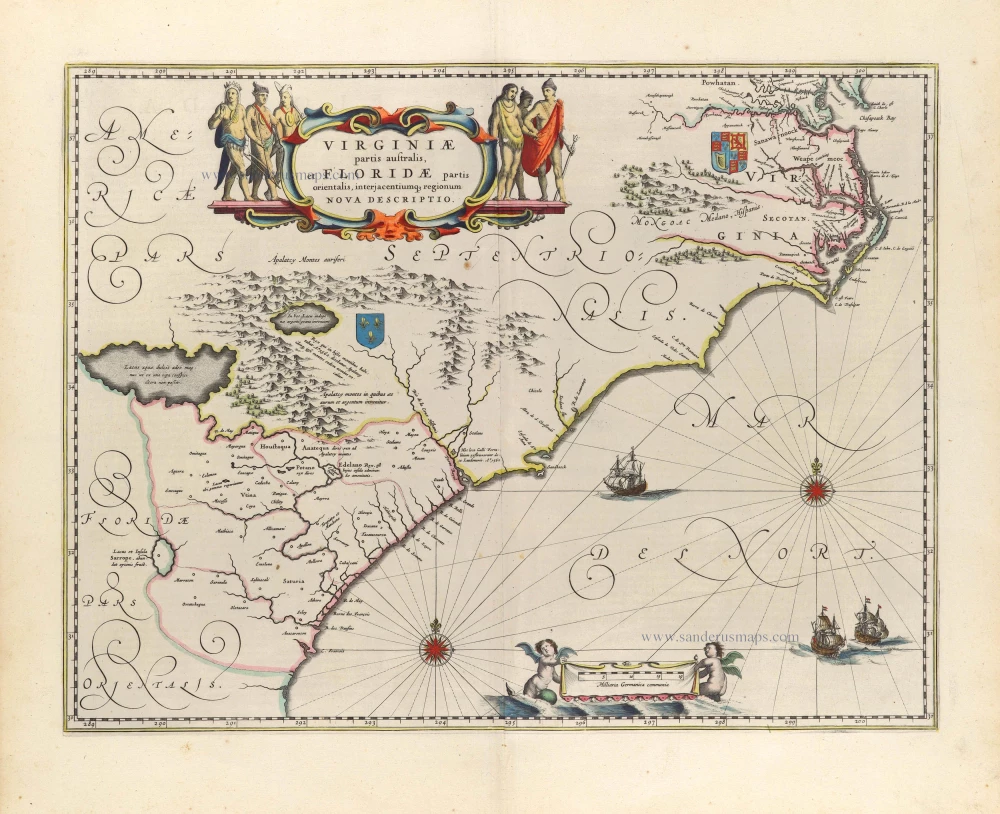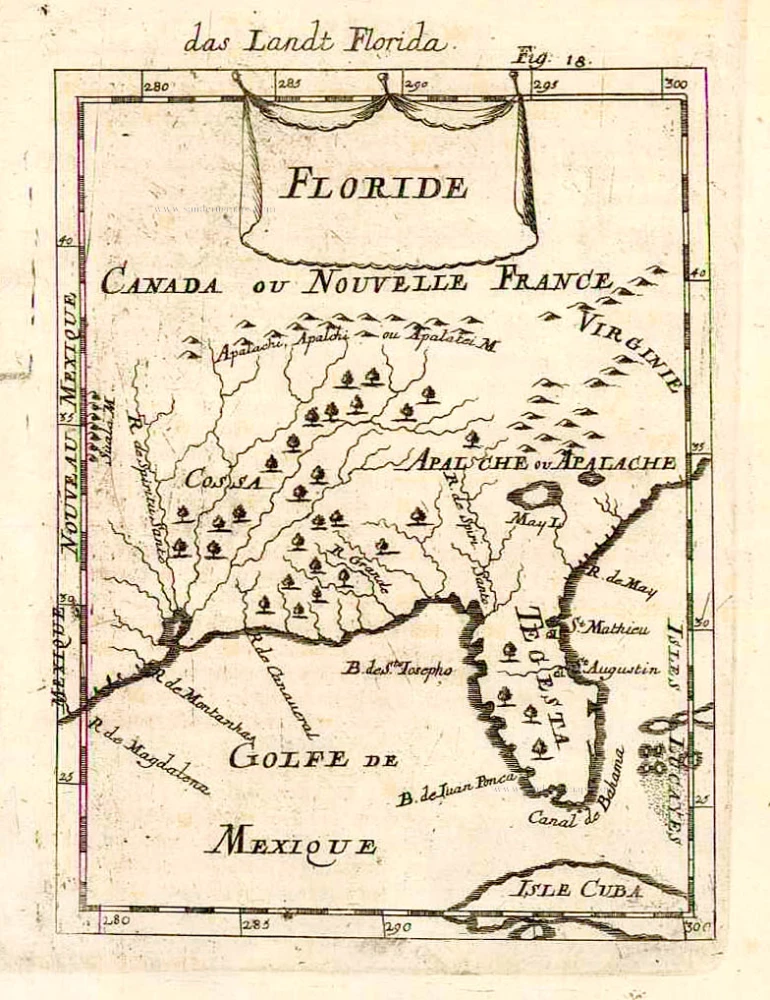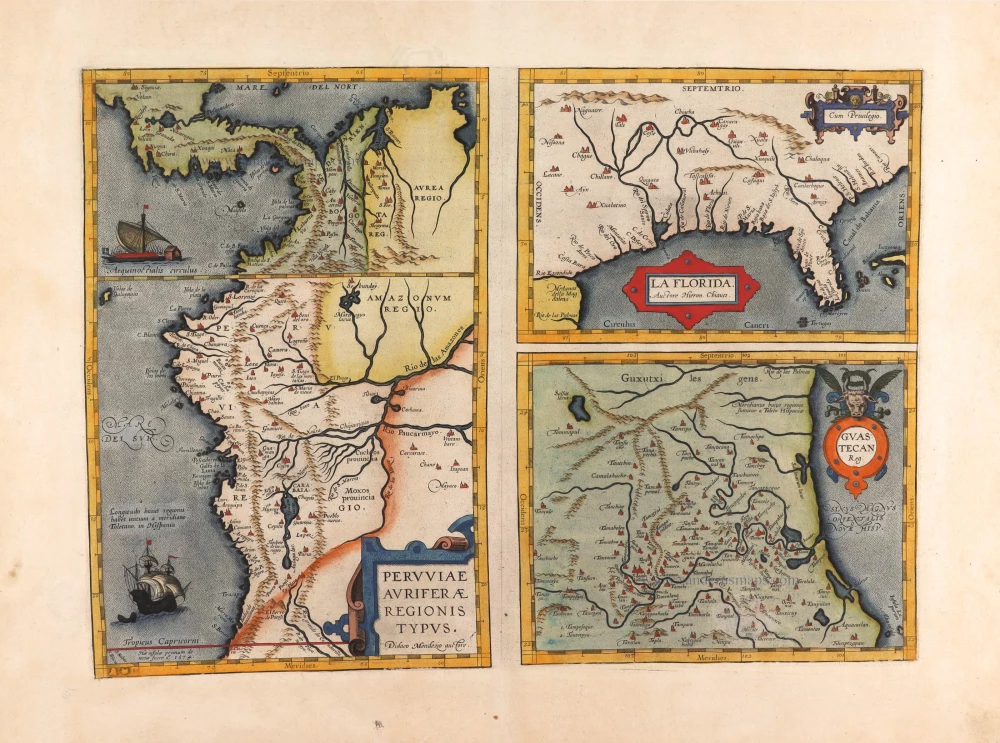Drake's raid on St. Augustine in 1586
St. Augustine (Florida) by Theodore de Bry, published by J.L. Gottfried. 1631
Commentary out of de Bry's Grand Voyages: "St. Augustyne is constructed out of Wood. It has beautiful, pleasing gardens and very fertile soil. Upon leaving this place, however, we burned it all to the ground. There are 150 men stationed here as part of the occupation, in the same way as 12 miles west, the Spanish stationed men at St. Helena to make sure the English and French could not pass through and seize the land around the town that had not yet been developed."
Theodore de Bry (1528 – 1598) and his family.
Theodore de Bry was born in 1528 in the Prince-Bishopric of Liège in the southern Netherlands (today Belgium). Trained as a goldsmith in his father's workshop, he left his home town around 1558 and moved to Strasbourg. Religious motives partly inspired his emigration, but commercial incentives were probably more critical for de Bry since Strasbourg was more attractive. Here, he gradually began to shift his focus to copper engraving. In the early 1560s, Theodore married Strasbourg-born Katharina Esslinger, and the couple went on to have four children together before Katharina died c. 1569. Johan Theodore (b. 1563) and Johan Israel (b. 1565) followed in their father's footsteps and took up his trade. He remarried in 1570 to Katharina Rölinger.
In 1577, after the Pacification of Gent had quietened religious tensions in the Netherlands, Theodore and his family moved to Antwerp. There, they lived close to the printing house of Christopher Plantin, and it was there that Theodore began making copper engravings. Copper engraving was a well-developed art in the Low Countries, and Antwerp artists were in great demand. In 1584, when Catholic troops besieged Antwerp, Theodore and his family moved to London, where he made copper engravings for an essential English navigation manual, The Mariners Mirrour. He also found the inspiration to produce the collection to which his name would forever be attached.
He met the artist Jacques Le Moyne de Morgues, a draughtsman who had been to Florida in the 1560s as part of a French expedition. He returned to Europe with watercolours of the natural world he had seen and the indigenous peoples. After Le Moyne's death, thanks to the mediation of Richard Hakluyt, Theodore acquired these drawings.
Hakluyt and de Bry began collaborating on a series of books about America. In 1588, the de Bry family moved to Frankfurt, where Theodore published the first volume of the America series. This first volume was the only one in the collection that appeared in four different languages: German, Latin, French and English. The following volumes appeared only in German and Latin. As a result, the relationship between de Bry and his English partners quickly soured.
Theodore continued publishing and produced a blend of richly illustrated prestigious volumes of the Voyages collection, the family firm's flagship publication.
Theodore de Bry died on March 27th, 1598. At this time, the highly successful and lucrative America series had already extended to seven volumes, and there would be fourteen. To these must be added the 'Elenchus', published in 1634 by Merian, which was a collective title and table of contents of these same volumes.
In 1597, the de Bry brothers published the first volume of the East India series. These were also published in folio but with slightly smaller page sizes than the America volumes. To distinguish the East India series from his America series, the two parallel sets subsequently became known among bibliophiles as de Bry’s Petits Voyages and his Grands Voyages, respectively.
The Petits Voyages consist of thirteen volumes, published between 1597 and 1633.
After Theodore de Bry's death, the business was run by his son, Johann Theodore and then by his grandson, Matthäus Merian and grandson-in-law, William Fitzer. Precisely what part de Bry's widow and his other son played in the business is unclear, but they certainly seemed to have retained some interest. After all, it must have become a very profitable venture for the whole family. Together, they continued to publish volumes of the Grands and Petits Voyages for another 46 years. The last volume, a third edition of Part IV of the America series, finally appeared in 1644.
Johann Ludwig Gottfried (ca. 1584 - 1633)
For a long time, Gottfried was considered a pseudonym of Johann Philipp Abelin, and his existence was denied.
From 1601, Johann Ludwig Gottfried studied theology in Heidelberg. From 1603 until 1624, he was first employed as a deacon and then as a reformed minister.
Through a Latin retelling of Ovid's Metamorphoses, he came into contact with the de Bry publishers in Oppenheim in 1619. From that moment on, thanks to his versatile language skills and his education, he worked as a valued employee for publishers in Oppenheim and Frankfurt, such as Johann Theodor de Bry, de Bry's nephew Lucas Jennis and de Bry's son-in-law Matthäus Merian the Elder. He provided translations, epigrams, paraphrases, and compilations for many of these publishers' extensive publications. As editor and proofreader, he supervised various publishing projects.
In 1624, he came to Frankfurt as a proofreader. He never completely gave up his spiritual office; from 1625 until the end of his life, he was officially a minister of the Reformed Church in Offenbach. He devoted himself undisturbed to his work as a translator and author for the Frankfurt publishing house (particularly for Merian).
His most extensive work is the Gottfried Chronicle. It was continued after his death by Johann Philipp Abelin in 1634 and remained a widely read historical work until the 18th century.
[No title]
Item Number: 32442 new Authenticity Guarantee
Category: Antique maps > America > North America
The conquest of St. Augustine (Florida) by Theodore de Bry, published by J.L. Gottfried.
No title.
Date of the first edition: 1620.
Date of this map: 1631.
Copper engraving, printed on paper.
Image size: 155 x 210mm (6 x 8¼ inches).
Sheet size: 360 x 220mm (14¼ x 8¾ inches).
Verso: German text
Condition: Excellent.
Condition Rating: A+.
From: GOTTFRIED J.L., Newe Welt und Americanische Historien. Inhaltende Warhafftige und volkommene Beschreibungen Aller West-Indianischen Landschaften Insulen Königreichen und Provinzen Seecusten fliessenden und stehenden Wassern Port und Anländungen. . . Frankfurt am Main, Matthias Merian, 1631.
Commentary out of de Bry's Grand Voyages: "St. Augustyne is constructed out of Wood. It has beautiful, pleasing gardens and very fertile soil. Upon leaving this place, however, we burned it all to the ground. There are 150 men stationed here as part of the occupation, in the same way as 12 miles west, the Spanish stationed men at St. Helena to make sure the English and French could not pass through and seize the land around the town that had not yet been developed."
Theodore de Bry (1528 – 1598) and his family.
Theodore de Bry was born in 1528 in the Prince-Bishopric of Liège in the southern Netherlands (today Belgium). Trained as a goldsmith in his father's workshop, he left his home town around 1558 and moved to Strasbourg. Religious motives partly inspired his emigration, but commercial incentives were probably more critical for de Bry since Strasbourg was more attractive. Here, he gradually began to shift his focus to copper engraving. In the early 1560s, Theodore married Strasbourg-born Katharina Esslinger, and the couple went on to have four children together before Katharina died c. 1569. Johan Theodore (b. 1563) and Johan Israel (b. 1565) followed in their father's footsteps and took up his trade. He remarried in 1570 to Katharina Rölinger.
In 1577, after the Pacification of Gent had quietened religious tensions in the Netherlands, Theodore and his family moved to Antwerp. There, they lived close to the printing house of Christopher Plantin, and it was there that Theodore began making copper engravings. Copper engraving was a well-developed art in the Low Countries, and Antwerp artists were in great demand. In 1584, when Catholic troops besieged Antwerp, Theodore and his family moved to London, where he made copper engravings for an essential English navigation manual, The Mariners Mirrour. He also found the inspiration to produce the collection to which his name would forever be attached.
He met the artist Jacques Le Moyne de Morgues, a draughtsman who had been to Florida in the 1560s as part of a French expedition. He returned to Europe with watercolours of the natural world he had seen and the indigenous peoples. After Le Moyne's death, thanks to the mediation of Richard Hakluyt, Theodore acquired these drawings.
Hakluyt and de Bry began collaborating on a series of books about America. In 1588, the de Bry family moved to Frankfurt, where Theodore published the first volume of the America series. This first volume was the only one in the collection that appeared in four different languages: German, Latin, French and English. The following volumes appeared only in German and Latin. As a result, the relationship between de Bry and his English partners quickly soured.
Theodore continued publishing and produced a blend of richly illustrated prestigious volumes of the Voyages collection, the family firm's flagship publication.
Theodore de Bry died on March 27th, 1598. At this time, the highly successful and lucrative America series had already extended to seven volumes, and there would be fourteen. To these must be added the 'Elenchus', published in 1634 by Merian, which was a collective title and table of contents of these same volumes.
In 1597, the de Bry brothers published the first volume of the East India series. These were also published in folio but with slightly smaller page sizes than the America volumes. To distinguish the East India series from his America series, the two parallel sets subsequently became known among bibliophiles as de Bry’s Petits Voyages and his Grands Voyages, respectively.
The Petits Voyages consist of thirteen volumes, published between 1597 and 1633.
After Theodore de Bry's death, the business was run by his son, Johann Theodore and then by his grandson, Matthäus Merian and grandson-in-law, William Fitzer. Precisely what part de Bry's widow and his other son played in the business is unclear, but they certainly seemed to have retained some interest. After all, it must have become a very profitable venture for the whole family. Together, they continued to publish volumes of the Grands and Petits Voyages for another 46 years. The last volume, a third edition of Part IV of the America series, finally appeared in 1644.
Johann Ludwig Gottfried (ca. 1584 - 1633)
For a long time, Gottfried was considered a pseudonym of Johann Philipp Abelin, and his existence was denied.
From 1601, Johann Ludwig Gottfried studied theology in Heidelberg. From 1603 until 1624, he was first employed as a deacon and then as a reformed minister.
Through a Latin retelling of Ovid's Metamorphoses, he came into contact with the de Bry publishers in Oppenheim in 1619. From that moment on, thanks to his versatile language skills and his education, he worked as a valued employee for publishers in Oppenheim and Frankfurt, such as Johann Theodor de Bry, de Bry's nephew Lucas Jennis and de Bry's son-in-law Matthäus Merian the Elder. He provided translations, epigrams, paraphrases, and compilations for many of these publishers' extensive publications. As editor and proofreader, he supervised various publishing projects.
In 1624, he came to Frankfurt as a proofreader. He never completely gave up his spiritual office; from 1625 until the end of his life, he was officially a minister of the Reformed Church in Offenbach. He devoted himself undisturbed to his work as a translator and author for the Frankfurt publishing house (particularly for Merian).
His most extensive work is the Gottfried Chronicle. It was continued after his death by Johann Philipp Abelin in 1634 and remained a widely read historical work until the 18th century.







